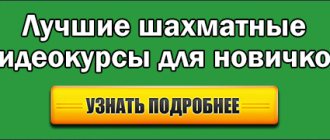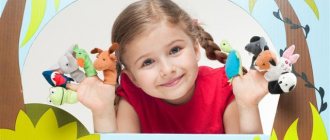Preschool age is a time when the cognitive, moral, and physical development of a child occurs especially intensively. In particular, it is before the age of 5-6 that a child acquires more than half of the total thinking skills that will be useful to him in the future. That is why it needs to be given special attention. In particular, it is at this age that the child should develop his first mathematical skills. Let's consider the theoretical foundations of the mathematical development of children of junior and senior preschool age.
Math lesson in kindergarten, senior group
Why is this so important?
- Mathematics is one of the most significant subjects. However, it is precisely this that often causes considerable difficulties for students.
- Studying this subject has a beneficial effect on the child’s cognitive abilities (thinking, memory, speech)
- Mathematical skills improve the emotional-volitional sphere, form perseverance and determination
- Improves the basics of a child's imagination

The role of mathematics in life
What skills should a child develop by the end of the preschool period?
By the end of the preschool period, the child should have the following mathematical skills:
- Ability to compare values based on basic characteristics; the formation of ideas about the concepts of “more-less”, “higher-lower”, etc.
- The ability to group objects according to their basic properties (basics - size, color, purpose, material, shape)
- Ability to compare parts and wholes; ability to assemble a picture from at least 12-24 fragments
- Developed counting skills and the ability to perform mathematical operations with numbers within ten
- Children’s development of quantitative and qualitative representations of the subject
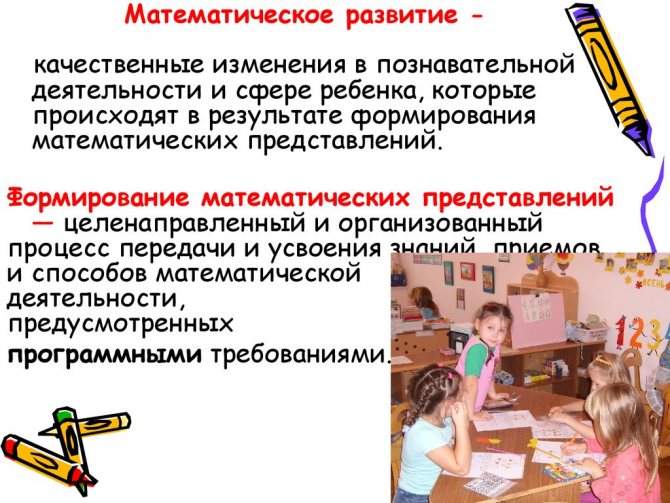
The essence of mathematical development
Methods of mathematical development as a science
Definition 1
Methodology of mathematical development is a branch of scientific knowledge that studies the processes of development of the cognitive sphere of children and the formation in them of the foundations of logical thinking and skills in performing elementary mathematical operations.
The methodology of mathematical development is focused on the formation of elementary mathematical concepts in preschoolers. She develops a methodology for their formation and determines the patterns of functioning of different areas of thinking and logic, which affect the overall development of the individual and the mastery of mathematical science.
Mathematical development is important for a child's overall development. Therefore, teaching mathematics occupies the core of the preschool educational program. Mathematical concepts activate the cognitive activity of a preschooler and develop his thinking abilities.
Are you an expert in this subject area? We invite you to become the author of the Directory Working Conditions
The methodology of mathematical development, as a science, is aimed at developing elementary mathematical concepts in children. This determines the following tasks of the methodology of mathematical development:
- Scientific confirmation of the level of mathematical development of preschool children at each stage of their development and the requirements for children to master the educational program.
- Development of the content of a preschool educational program in the area of mathematical education and development.
- Determination of optimal means and methods, technologies and forms of teaching preschoolers the basics of mathematics.
- Creating conditions for continuity in mathematical education of preschoolers and primary schoolchildren.
- Preparing teachers for professional activities in the field of mathematical education and development of preschool children.
- Development of recommendations for the mathematical development of a child by parents.
- Development of the main directions of cognitive activity, focused on the child’s mathematical development when engaged in different types of activities (work, sports, etc.).
Finished works on a similar topic
Course work Methodology of mathematical development 430 ₽ Abstract Methodology of mathematical development 260 ₽ Examination Methodology of mathematical development 240 ₽
Receive completed work or specialist advice on your educational project Find out the cost
Since the methodology of mathematical development is a scientific branch, it has connections with other sciences. It is closely related to developmental psychology, which determines the functioning of a child’s mental processes, sensitive periods of development of specific areas, and helps in developing optimal methods for the formation of elementary mathematical concepts in preschoolers of different age groups. In addition, the methodology of mathematical development is closely related to pedagogy. This connection can be traced in the reliance of this science on didactic methods and principles of teaching children mathematics.
In addition, there is a connection between this scientific field and sociology, anthropology, mathematics, special pedagogy and cultural studies.
The subject of the methodology of mathematical development is teaching mathematics, implemented in certain forms and focused on achieving specific goals and objectives.
The object of research into the methodology of mathematical development is the methods and means of mathematical teaching used in the preschool education system.
Necessary conditions for conducting math classes with a child
What is the theory and methodology of mathematical development for preschoolers based on? In order for the lessons to be truly interesting for the child, and for him to assimilate information faster and easier, they must be built taking into account the following recommendations:
- The use of visual didactic material selected taking into account the age and other individual characteristics of the child
- The presence of a clear plot for the lesson according to which its development will take place
- Selection of tasks in strict accordance with the age characteristics of the child and the level of his intellectual development
- Using a variety of methods and forms to create the basis of work (these include solving logical problems, didactic games, working with handouts, etc.)
- Multitasking (focus on the development of spatial, temporal, quantitative concepts)
- Using a game form of conducting classes
- Emphasis on the formation of gaming motivation; elements of surprise and surprise
- Helping the child not only master a certain system of knowledge and skills, but also develop his skills of independent cognitive activity, independence of judgment, etc.
- Formation of an optimal developmental environment for the development of basic cognitive processes in a child
- Teaching children to perceive the quantitative and qualitative features of objects, forming appropriate ideas
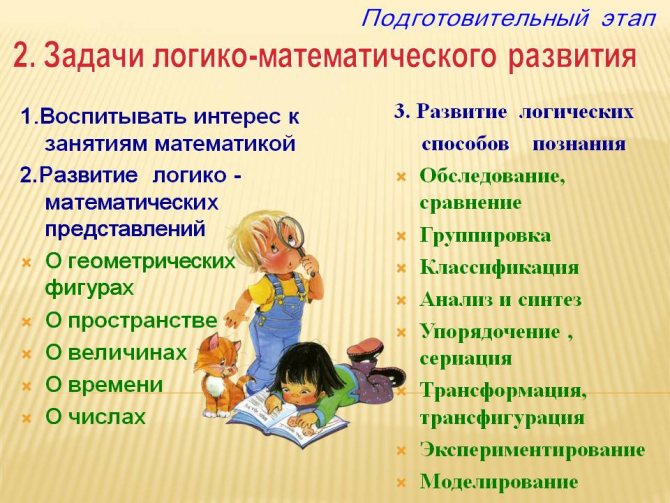
Objectives for the development of mathematical abilities
The concept of "Method"
In the theory and methodology of children's mathematical development, the term “method” is used in two senses: broad and narrow.
The method is a historically established approach to the mathematical preparation of children in kindergarten (monographic, computational and the method of reciprocal actions).
When choosing methods, the following are taken into account:
- goals, objectives of training;
- the content of the knowledge being formed at this stage;
- age and individual characteristics of children;
- availability of necessary teaching aids;
- the teacher’s personal attitude to certain methods;
- specific conditions in which the learning process takes place, etc.
At the beginning of the 20th century. the classification of methods was mainly carried out according to the source of knowledge - these were verbal, visual, practical methods.
Practical methods
- (exercises, experiments, productive activities) are most consistent with the age characteristics and level of development of thinking of preschoolers. The essence of these methods is that children perform actions that consist of a number of operations.
- Practical methods are characterized primarily by independent performance of actions and the use of didactic material. On the basis of practical actions, the child develops the first ideas about the knowledge being formed. Practical methods ensure the development of skills and abilities and allow the widespread use of acquired skills in other types of activities.
Visual and verbal methods in teaching mathematics are not independent. They accompany practical and playful methods. But this does not detract from their importance in the mathematical development of children.
Visual and verbal methods
Visual teaching methods include: demonstration of objects and illustrations, observation, demonstration, examination of tables and models.
Verbal methods include: storytelling, conversation, explanation, explanations, verbal didactic games. Often in one lesson different methods are used in different combinations.
Techniques
The components of the method are called methodological techniques.
The main ones used in mathematics classes are: overlay, application, didactic games, comparison, instructions, questions for children, examination , etc.
Reception "Show"
- A widely used methodological technique is demonstration .
- This technique is a demonstration; it can be characterized as visually practical and effective.
- There are certain requirements for the display: clarity and dissection; consistency of action and word; accuracy, brevity, expressiveness of speech.
Reception "Instructions"
One of the essential verbal techniques in teaching children mathematics is instruction , which reflects the essence of the activity that the children have to perform.
Reception “Questions for Children”
Questions for children occupy a special place in the methodology of teaching mathematics . They can be reproductive-mnemonic, reproductive-cognitive, productive-cognitive. In this case, the questions must be accurate, specific, and concise. They are characterized by logical consistency and variety of formulations.
Features of the formation of mathematical concepts depending on age
Considering that preschool age is conventionally divided into three main periods, goals, objectives, as well as methods and forms of mathematical education of children will also differ.
Junior preschool period. At this time, the necessary mathematical skills and concepts are just beginning to develop. Therefore, the child needs to be given an idea of basic operations. The best games for developing thinking skills are children's mosaics (from 5 fragments), addition of geometric shapes (from 4 parts). The method of developing quantitative and qualitative concepts in preschoolers requires special attention.
Middle preschool period. There is an active development of the sign-symbolic function of consciousness. The child can already be taught to count and the simplest mathematical operations. The foundations of logical thinking are laid. The most preferred games include: “Nonsense”, “Count the objects”, “Find a pair”, “Mathematical lotto”, “Domino figures”. To develop a child’s analytical and synthetic abilities, you can offer him games like tangram, where he will need to make a geometric figure, a silhouette of an animal, etc. from individual parts.
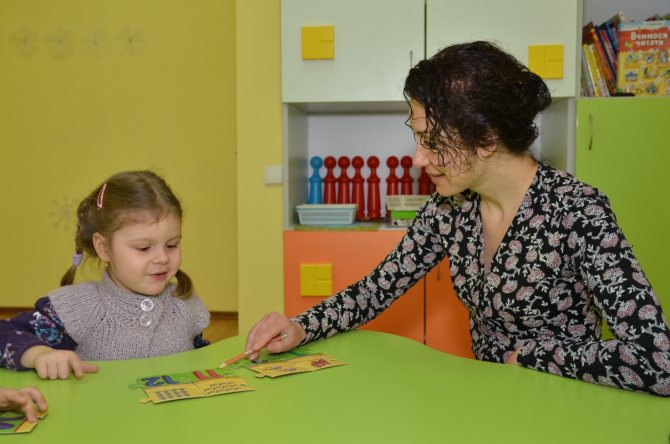
Individual lesson to determine the level of mathematical development
In older preschool age, the child’s independence and his ability to self-organize begin to play an increasingly noticeable and significant role. Logical thinking is becoming increasingly important.
The child begins to try to compose stories from pictures, compose logical series, observing the correct sequence of elements.

Math tests for kids 3-4 years old
3.4. Forms of work on pre-mathematical development of children
3..4. Forms of work on pre-mathematical development of preschool children.
- Forms of work on pre-mathematical development of preschool children.
- Types and types of occupations, their features, structure
- Forms of work outside of class
- Forms of work on pre-mathematical development of preschool children.
In didactics, “form” (device, structure, system of organization, internal structure) is considered as a way of constructing educational activities. Organizational forms of education must reliably ensure the implementation of the objectives of the educational process, the ultimate goal of which is to promote the comprehensive and, first of all, intellectual development of children.
Variety of training forms
is determined by the number of students, the place and time of classes, the methods of children’s activities, as well as the methods of managing this activity by the teacher.
Based on the characteristics of the organization of training, determined by the number of students, there are individual, collective and group (differentiated) forms of training.
.
Individual training
– lies in the fact that the child receives new ideas, performs different tasks, and has the opportunity to receive direct help from an adult.
Collective learning
– involves the work of a teacher with a group of children. There is mutual assistance and mutual learning. The disadvantage is that individual differences are not sufficiently taken into account.
Differentiated learning
in pedagogical practice it is called “group”, “individual-group”, or “collective-group” learning.
Differentiated training is carried out according to the following criteria:
- by ability or inability to learn;
- by interest;
- by volume of material and degree of complexity;
- by the degree of independence and pace of progress in learning.
In the 40s of the 20th century, Leushina A.M. first proposed classes as a form of teaching mathematics in kindergarten
. Metlina L.S. in the 80s she developed notes for mathematics lessons for all age groups of preschool children. Until the 90s, it was believed that the main form of teaching mathematics to preschoolers was the classroom. To teach children mathematics, classes were held once a week.
However, it must be taken into account that those mathematical concepts that are formed in preschool age are of an applied nature for children. Children need mathematical concepts for daily orientation in the world around them. Therefore, they should be formed in a variety of activities (communication, play, cognitive-practical, artistic, labor).
- Types and types of occupations, their features, structure.
At the present stage of development of the preschool education system, state documents (Code on Education of the Republic of Belarus, Standards of Preschool Education, Model Curriculum for Preschool Education) determine the status of the game, classes
as
the main form
of a specially organized educational process.
The number of classes in
the educational field
“
Elementary mathematical concepts
” and the time allotted for their implementation are regulated by the Standard Preschool Education Curriculum.
- first junior group – once every 2 weeks (10 min.)
- second junior group – 1 time per week (15 min.)
- middle group – 1 time per week (20 min.)
- senior group 5-6 years old – once a week (25 min.)
- senior group 6-7 years old – once a week (30 min.)
Classes in the educational area “Elementary Mathematical Concepts” are held mid-week in the morning in combination with classes that do not require a high mental load (physical education, music classes or visual arts classes).
During the holidays, these classes are not conducted; the concepts and skills acquired by children are consolidated in everyday life: in games, play exercises, on walks, etc.
In all age groups, classes are conducted frontally, i.e. simultaneously with all children. Only in the first junior group is it recommended to conduct classes in subgroups (6-8 people), including all children, in order to gradually teach them to study together.
Requirements for conducting classes
in the educational field “Elementary mathematical concepts”
- are built taking into account general didactic principles: scientific character, systematicity and consistency, accessibility, clarity, connection with life, individual approach to children, etc.;
- implement all the contents of the educational field “Elementary mathematical concepts”;
- the implementation of educational, educational and developmental tasks in the classroom occurs in a comprehensive manner;
- the content of each specific lesson, the formulation of its tasks, is carried out on the basis of the content of the educational field “Elementary mathematical concepts”, taking into account the characteristics of children and their level of development;
- each lesson occupies its own, strictly defined place in the system of lessons for the study of a specific program task in the educational field “Elementary mathematical concepts”;
- The program objectives of the lesson determine its structure. In the structure of the lesson, separate parts are distinguished: from one to four or five, depending on the number, volume, nature of the tasks and the age of the children. All parts of the lesson are independent, varied and related to one another;
- in one lesson one new problem is solved, the rest are for repetition and consolidation;
- new material is given in the first part of the lesson, as it is mastered, it moves to other parts; subsequent parts of the lesson are usually conducted in the form of a didactic game, in which children’s ideas and skills are consolidated and applied in new conditions;
- widespread use of didactic games and exercises with handouts;
- organization of physical education (after the first or second part).
Since the leading activity in preschool age is play, play methods and techniques of interaction between teacher and student are predominant in the lesson, i.e. classes can be of a playful nature or presented as play-based didactic complexes.
In accordance with the didactic objectives, the type of lesson is determined:
- Training type
(learning new ideas).
Goal:
setting cognitive tasks for children, presenting, expanding and clarifying children’s ideas about quantity, size, geometric figures and the shape of objects, space and time;
- Fastening type
(consolidation and systematization of children’s accumulated experience).
Goal:
understanding the perceived ideas and forming primary generalizations.
- Combined (mixed) type
classes.
Goal:
learning new content and repetition, consolidation and systematization
Types of activities
in the educational field "Elementary mathematical concepts"
Combined lesson
can be integrated - by selecting objects of knowledge from different educational fields or components of one educational field; can be playful or non-playful - according to the predominance of methods of educational interaction, according to the nature of the interaction between students and the teacher, and between students.
Its structure:
- Organizing time.
- Implementation of the learning task. Mastering new material.
- Consolidating newly acquired ideas in children’s independent activities.
- Movable pause.
- Implementation of educational content from other components of the educational field.
- Bottom line.
Complex lesson
involves a combination of classes in the educational area “Elementary mathematical concepts” with classes in other educational areas. In this case, in the lesson on the formation of elementary mathematical concepts (it is the first part of a complex lesson), learning tasks are implemented, children master new educational content, and in classes in other educational areas - the use, consolidation, expansion, clarification, deepening of the newly mastered educational content takes place. content. The structure of a complex lesson is flexible and variable. It should be remembered that the greatest pedagogical effect can be achieved by combining classes in the educational area “Elementary mathematical concepts” with classes in the educational area “Art”, “Child and Society”, “Child and Nature”.
Game complexes with mathematical content
(as a game version of a combined lesson):
- didactic in nature.
A didactic game is selected to solve each program problem, and children play it either in a sequence determined by the plot of the lesson, or in a random sequence determined by the “magic arrow”, spinning top, child’s choice, etc.;
2) educational and developmental in nature.
Complex diagram:
- a game or gaming exercise to develop attention, perception, sensation, and activate memory;
- a game or game task for the development of reproductive thinking, the formation of certain mathematical concepts (training);
- a game or play exercise that helps develop independent reproductive thinking and consolidate acquired ideas in independent practical activities;
- an outdoor game or exercise aimed at increasing motor activity, consolidating mathematical concepts, and developing cognitive processes;
- a game or play exercise for the development of divergent thinking (creative, productive), imagination, logical thinking, the formation in children of the ability to use their ideas in new conditions, the development of elements of logical thinking;
- a game or play exercise for relaxation and imagination development.
Lesson using educational visual aids
(
with individual notebooks).
Structure:
- Didactic game or game exercise.
- Work with educational visual aids (formation of new ideas, expansion and deepening of the mastered material).
- An outdoor game, or a relay game, or a physical education break.
- Working with educational visual aids (completing graphic tasks, actions with cut material).
- Didactic game or game exercise.
Classes using computers.
In some preschool institutions there are computer and gaming complexes (one room is a computer class, the second is a room for mental and physical relaxation).
Advantage
this form: the possibility of an individual approach to learning, the computer is an interesting toy for the child - children develop attention and interest in learning, etc.
If you violate the rules for using a computer, your work can have a negative effect.
A child 4-6 years old can be at the computer for no more than 10 minutes, 1-2 times a week (otherwise the child’s posture, vision, and psyche will be impaired). Therefore, with the help of a computer it is necessary to solve only those software problems that are solved less effectively in other forms.
- Forms of work outside of class
(unregulated activity)
Individual work
with the child allows for pedagogical correction. The forms of this work are exercises, work with individual material (notebooks, didactic material), etc.
Game with mathematical content.
It is planned at least 2-3 times a week individually, in a group (or part of it).
All types of games can be planned. Didactic games.
There are many collections with d/i on mathematics by such authors as Sai, Udaltsova, Mironova, Starzhinskaya, Novikova.
Plot-didactic games
(this term was proposed by A. Smolentsova, “Plot-didactic games with mathematical content,” 1985)
Educational games
. Proposed by Z.A. Mikhailova, B.P. Nikitin (“Steps of creativity or educational games”).
On the day of the lesson in the educational area “Elementary mathematical concepts”, a game with mathematical content is not planned.
Examination.
It is planned at least 2 times a week individually, in a group (or part of it) when developing the ability to group objects; establishing a one-to-one correspondence in a practical way; bills by touch; dividing a whole into parts; comparing quantities and ordering; examination of geometric figures and determination of the shape of an object; orientation from oneself, in the surrounding environment.
Experiences, experiments.
Planned as needed, but no more than once a week individually, in a group (or part of it) while developing an understanding of the independence of number from qualitative and spatial characteristics; understanding the dependence of the result of ordinal counting on the direction of counting and the independence of the result of quantitative counting on the direction of counting; skills of transfiguration and transformation.
Observations.
Planned daily individually, in a group while forming ideas about the parts of the day and their sequence; ideas about the seasons and their sequence.
Story, conversation.
Planned as necessary individually, in a group when forming temporary ideas; ideas about geometric figures and the shape of objects; ideas about size, about ordering by size.
Entertainment with mathematical content.
It is planned no more than 1 time per quarter by group. It can be planned as a competition, theatrical or circus performance, folklore festival, travel, etc. It can replace a complex lesson or game complex. On this day, a lesson in the educational area “Elementary Mathematical Concepts” is not planned.
Viewing works of fine art.
It is planned as needed, but at least once a month by the group (or part of it) when forming quantitative, spatial and temporal ideas; ideas about size and space. Artistic illustrations, photographs, reproductions of paintings, paintings (still lifes, everyday life, animalistic, mythological genres) are used.
Reading literary works with mathematical content.
It is planned as needed, but at least once a month by the group (or part of it). When reading, mathematical characteristics, mathematical actions (their necessity, sequence, correctness, adequacy of the situation, etc.) that are performed by the heroes of the works are highlighted.
Independent cognitive activity
:
- games with didactic material,
- role-playing games,
- situations of work and everyday activities.
- working with a book (coloring, cutting out, comparing by size): books like coloring books, books like math notebooks - “Geometry for Kids”, etc.,
- performing entertaining exercises (puzzles, games with sticks)
Signs of independent cognitive activity are:
children's interest in it; manifestation of creative initiative; independence in choosing a game and how to implement the plan.
In independent cognitive activity, children’s ideas about numbers, sizes, geometric shapes, time, and space are clarified, deepened and expanded.
Each of the listed forms is planned in different types of activities with a certain frequency and has specifics in the way children are organized, depending on the age group and the content of the problem being solved.
LITERATURE
- Zhitko, I.V. Formation of elementary mathematical concepts in children from 4 to 5 years old: educational method. A manual for preschool teachers. education. Minsk: Ecoperspective, 2016. – 200 p.
- Formation of elementary mathematical concepts in preschoolers / ed. A.A.Stolyar. – M., Education 1988
- Shcherbakova, E.I. Methods of teaching mathematics in kindergarten: a textbook for preschool students. department and faculty avg. ped. textbook establishments. M., Ed. , 1998 – 272s
6
What methods are best used to develop a preschooler's mathematical understanding?
The visual method plays the most important role in teaching children mathematics, especially when it comes to the early preschool period.
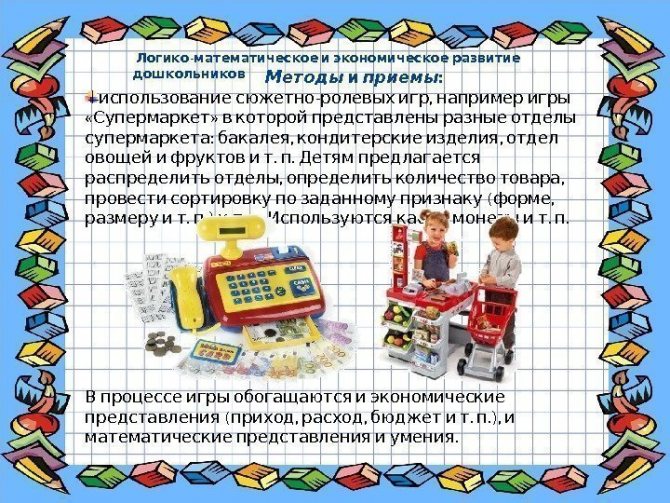
Methods for developing mathematical knowledge
There are the following types of visual teaching methods:
- Working with handouts or demonstration materials. Using a plotless or plot method (you can take as a basis the plot of any fairy tale familiar to a child, where counting or numbers would appear)
- Volumetric or planar. Classes using special counting materials (for example, children's abacus, sticks, cubes, etc.)
- Homemade or factory made.

In order to use visual material more effectively, it is necessary to build developmental classes taking into account the following patterns:
- The study of each new topic should begin with more voluminous visual material. This will make it easier for the child to understand
- As the child grows up, it is necessary to ensure that the proportion of volumetric and plot-based visual material decreases, and the proportion of flat and plotless material increases
- It is advisable to use several types of visual material to solve one software problem
- It is very advisable to familiarize the child with new material in advance.
Separately, it is worth considering the requirements for visual aids.

As we have already indicated above, it can be either ready-made at the factory or made by parents. However, it is important that it matches the following:
- Hygiene. Toys must be made from environmentally friendly, safe materials and have all the necessary certificates
- Aesthetics. Attractive material is more likely to attract the child's attention
- A reality that allows a child to perceive the material being studied without distortion
- Durability and reliability
- Variety and sufficient quantity to allow the use of variable techniques
- The principle of logical construction that combines the basics of the material
- Uniformity
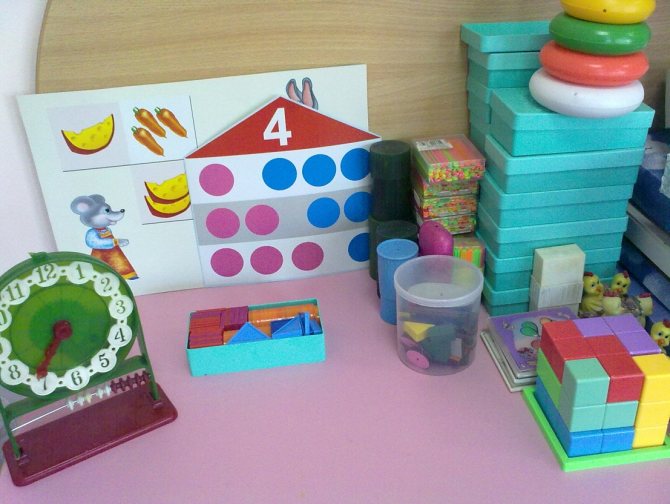
A significant advantage of the practical teaching method is that it most fully explains to the child why he is studying this or that material. And how exactly will the knowledge gained be useful to him in the future?
- Active application in practice of a variety of didactic material
- Performing a variety of both mental and practical activities
- Development of the skill of predicting the outcome of actions with various types of didactic material
- Not only instilling mathematical skills in the child, but also a detailed explanation of their role in the child’s life (in play activities, in everyday life, etc.)
The verbal method of teaching is based on direct interaction between the child and the parent or teacher.
That is why the main requirements for this method will be aimed at the speech of the participants in the process
The speech of the parent or teacher should be:
- Literate
- Rosary
- Emotional and alive
- Available
- Friendly
- Moderately loud

The pace of speech, its intonation and other features must be adjusted depending on the individual age characteristics of the child. For example, a child of primary preschool age perceives rather slow speech much better; unformed memory processes require repeated repetitions.
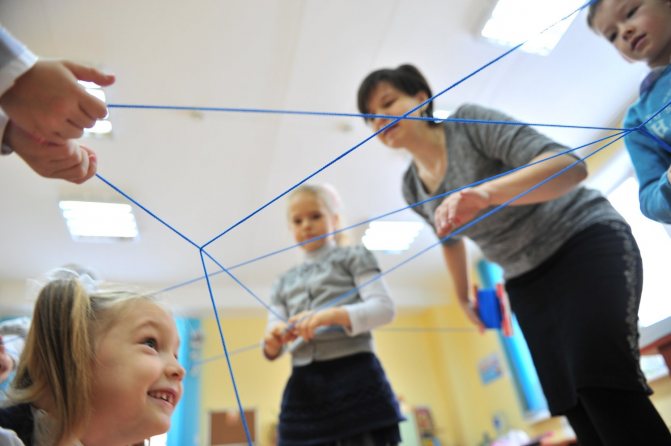
Development of logic and spatial thinking in a playful way
When talking with an older child, you can somewhat speed up the pace of speech and also make more active use of problem situations.
Certain requirements are also imposed on children’s speech. She must be:
- Competent
- Contain the necessary mathematical terminology and basic mathematics by age
- Legible and understandable
- The child must speak in complete common sentences with correct grammatical structure
- Have sufficient volume
Methods of teaching children mathematics
Lecture 5.
| 1. Methods of teaching children mathematics. 2. The special role of game and practical methods in the acquisition of mathematical knowledge. 3. Didactic visual material: types of visual material, principles of its selection for classes with children. 4. Methodology for teaching the formation of sets from individual elements based on the selection of properties, the selection of elements from a set and the comparison of sets using techniques of superposition and application by establishing one-to-one correspondences |
Different sciences use the concept of method due to their specificity. Thus, philosophical science interprets method (Greek metodos - literally “a path to something”) in the most general sense as a way of achieving a goal, a certain way of ordering activity.
A method is a method of reproduction, a means of cognition of the subject being studied . The methods are based on objective laws of reality. The method is inextricably linked with theory.
In pedagogy, the method is characterized as a purposeful system of actions of the teacher and children corresponding to the goals of learning, the content of educational material, the very essence of the subject, and the level of mental development of the child.
In the theory and methodology of children's mathematical development, the term “ method ” is used in two senses : broad and narrow. The method can denote a historically established approach to the mathematical preparation of children in kindergarten (monographic, computational and the method of reciprocal actions).
In pedagogy, is a concept that is based on the use of one method (mono-method). This concept includes the theory of the gradual formation of mental activity (P. Ya. Galperin, N. F. Talyzina). The process of activity formation is considered by the authors as a process of transferring social experience. This does not occur exclusively through the interaction of the teacher with students, but rather through the internalization of the corresponding activity, shaping it first in an external material form, and then transforming it into internal mental activity.
However, forcing any one teaching method has not received proper confirmation in practice.
The most rational , as experience shows, is a combination of various methods .
When choosing methods, take into account:
— goals, objectives of training;
— the content of the knowledge being formed at this stage;
— age and individual characteristics of children;
— availability of necessary didactic tools;
- personal attitude of the teacher to certain methods;
— specific conditions in which the learning process takes place, etc.
The theory and practice of teaching has accumulated some experience in using different teaching methods in working with preschool children. In this case, the classification of methods is used based on teaching aids.
At the beginning of the 20th century . The classification of methods was mainly carried out according to the source of knowledge - these were verbal, visual, practical methods .
Practical methods (exercises, experiments, productive activities) are most consistent with the age characteristics and level of development of thinking of preschoolers. The essence of these methods is that children perform actions that consist of a number of operations. For example, counting objects: name the numerals in order, correlate each numeral with a separate object, pointing at it with a finger or fixing your gaze on it, correlate the last numeral with the entire quantity, remember the total number.
However, excessive use of practical methods and delays at the level of practical actions can negatively affect the development of the child.
Practical methods are characterized primarily by independent performance of actions and the use of didactic material. On the basis of practical actions, the child develops the first ideas about the knowledge being formed. Practical methods ensure the development of skills and abilities and allow the widespread use of acquired skills in other types of activities.
Visual and verbal methods in teaching mathematics are not independent. They accompany practical and playful methods. But this does not at all detract from their importance in the mathematical development of children.
Visual teaching methods include: demonstration of objects and illustrations, observation, demonstration, examination of tables and models.
Verbal methods include: storytelling, conversation, explanation, explanations, verbal didactic games. Often in one lesson different methods are used in different combinations.
The components of the method are called methodological techniques .
The main ones used in mathematics classes are: overlay, application, didactic games, comparison, instructions, questions for children, examination, demonstration, etc.
As is known, mutual transitions between methods and methodological techniques . Thus, a didactic game can be used as a method, especially in working with younger children, if the teacher develops knowledge and skills through the game, but it can also be used as a didactic technique when the game is used, for example, to increase the activity of children (“Who is faster?” ?”, “Get things in order”).
widely used methodological technique is demonstration . This technique is a demonstration; it can be characterized as visually practical and effective.
There are certain requirements for the display clarity and dissection; consistency of action and word; accuracy, brevity, expressiveness of speech.
One of the essential verbal techniques in teaching children mathematics is instruction , which reflects the essence of the activity that the children have to perform. In the senior group, the instructions are holistic in nature and are given before completing the task. In the younger group, the instructions should be short, often given as the actions are performed.
Questions for children occupy a special place in the methodology of teaching mathematics . They can be reproductive-mnemonic, reproductive-cognitive, productive-cognitive . In this case, the questions must be accurate, specific, and concise. They are characterized by logical consistency and variety of formulations. In the learning process there should be an optimal combination of reproductive and productive issues, depending on the age of the children and the material being studied. Questions are valuable because they provide development of thinking. Prompt and alternative questions should be avoided.
The system of children's questions and answers in pedagogy is called conversation . During the conversation, the teacher monitors the children’s correct use of mathematical terminology and speech literacy. This is accompanied by various explanations. Thanks to explanations, children’s immediate perceptions are clarified. For example, a teacher teaches children to examine a geometric figure and explains: “Take the figure in your left hand - like this, trace it with the index finger of your right hand, show the sides of the square (rectangle, triangle), they are the same. A square has corners. Show me the corners." Or another example. The teacher teaches children how to measure, showing practical actions with explanations of how to apply a measure, mark its end, remove it, and apply it again. Then he shows and tells how measures are calculated.
The older the children , the more important problematic issues and problematic situations are in their learning .
Problem situations arise when:
— the connection between fact and result is not revealed immediately, but gradually. This raises the question: what is it? (we lower different objects into the water: some drown, others don’t);
- after presenting some of the material, the child needs to make an assumption (an experiment with warm water, melting ice, problem solving);
- the use of the words “sometimes”, “some”, “only in certain cases” serves as a kind of identifying signs or signals of facts or results (games with hoops);
- for the concept of a fact, it is necessary to compare it with other facts, create a system of reasoning, that is, perform some mental operations (measurement with different measures, counting in groups, etc.).
Numerous experimental studies have proven that when choosing a method, it is take into account the content of the knowledge being generated . Thus, in the formation of spatial and temporal concepts, the leading methods are didactic games and exercises (T. D. Richterman, O. A. Funtikova, etc.). When introducing children to shape and size, along with various play methods and techniques, visual and practical ones are used.
The place of the game method in the learning process is assessed differently . In recent years, the idea of the simplest logical training of preschoolers has been developed, introducing them to the field of logical-mathematical concepts (properties, operations with sets) based on the use of a special series of “educational” games (A. A. Stolyar). These games are valuable because they actualize the hidden intellectual capabilities of children and develop them (B. P. Nikitin).
It is still possible to ensure comprehensive mathematical training for children with a skillful combination of game methods and direct teaching methods . Although it is clear that the game captivates children, it does not overload them mentally and physically. The gradual transition from children's interest in play to interest in learning is completely natural.
All visual material can be divided into two types : demonstration and handout .
The demonstration one differs from the dispensing one in size and purpose. Demonstration material is larger in size, and handout material is smaller.
The importance of demonstration visual material lies in the fact that with its help it is possible to make the learning process interesting, accessible and understandable to children, to create conditions and sensory support for the formation of specific mathematical concepts, for the development of cognitive interests and abilities.
The importance of handout visual material lies primarily in the fact that it makes it possible to give the learning process an effective character and to involve the child directly in practical activities.
Visual aids can be real objects and phenomena of the surrounding reality, toys, geometric figures, cards depicting mathematical symbols - numbers, signs, actions (Fig. 1-4); verbal clarity is widely used - a figurative description of an object, a phenomenon of the surrounding world, works of art, oral folk art, etc.
The nature of visibility, its quantity and place in the educational process depend on the purpose and objectives of learning , on the level of children’s acquisition of knowledge and skills, on the place and relationship between the concrete and abstract at different stages of knowledge acquisition.
Thus, when forming children’s initial ideas about number and counting, various concrete sets are widely used as visual material, and their diversity is very significant (a variety of objects, their images, sounds, movements). The teacher draws the children's attention to the fact that a set consists of individual elements; it can be divided into parts (subset). Children practically act with set, gradually mastering this property of set with a visual comparison - quantity.
Visual material helps children understand that any set consists of separate groups of objects that can be in the same or unequal quantitative ratio, and this prepares them for mastering counting using numeral words. At the same time, children learn to arrange objects with their right hand from left to right.
Gradually, mastering the counting of sets consisting of different objects, children begin to understand that the number does not depend either on the size of the objects or on the nature of their placement. By practicing visual quantitative comparison of sets, children in practice become aware of the relationships between adjacent numbers (6 is less than 7, and 7 is more than 6) and learn to establish equality. At the next stage of training, concrete sets are replaced by “numeric figures”, “numerical ladder”, etc.
Pictures and drawings are used as visual material . Thus, examining artistic paintings makes it possible to realize, highlight, and clarify temporal and spatial relationships, characteristic features of the size and shape of surrounding objects.
At the end of the third - beginning of the fourth year of life, the child is able to perceive a multitude represented with the help of symbols, signs (squares, circles, etc.). The use of signs (symbolic clarity) makes it possible to highlight essential features, connections and relationships in a certain sensory-visual form. Symbolic clarity is of particular importance when teaching children computational activities (the use of numbers, symbols of arithmetic operations, models), when forming their spatial and temporal concepts.
Without the child’s direct practical orientation in space, the formation of spatial ideas and concepts is impossible. However, at a certain stage of learning, when children need to understand spatial relationships, what is more important is not practical orientation in space, but rather the perception and understanding of spatial relationships with the help of graphs, diagrams, and models.
The formation in children of ideas and concepts about size and shape simply impossible without clarity . In this regard, various figures are used as standards of form, graphic and model images of form . One of the most common forms of visuals are study tables . The use of tables has a pedagogical effect only if their demonstration is connected not only with the teacher’s explanation during the presentation of new material, but also with the organization of children’s independent work.
In mathematics classes, application aids (a table with replaceable parts that are fixed on a vertical or inclined plane using magnets or other means) and flannelgraphs are widely used. This form of visibility allows children to take an active part in making applications and make learning activities more interesting and productive. Application aids are dynamic and provide the opportunity to vary and diversify models. For example, using a flannelgraph it is convenient to regroup geometric shapes and solve arithmetic problems and examples.
Visual aids also technical training aids (TSO). Among the technical means of teaching mathematics, screen media - TV, screens, etc. - acquire the greatest importance. The use of technical means makes it possible to more fully realize the teacher’s capabilities and use ready-made isographic or printed materials.
Teachers can make visual material themselves, as well as involve children in this (especially when making handout visual material).
The material is made from paper, cardboard, foam rubber, papier-mâché. Natural materials (chestnuts, acorns, pebbles) are often used as counting material. To ensure that this material has an aesthetic appearance, it is coated with paints and varnishes.
To illustrate various concepts associated with sets of objects, universal sets are often used . Such block sets were once proposed by L. S. Vygotsky and the Hungarian mathematical psychologist D. Gyenes. Later, A. A. Stolyar developed this material in more detail and described logical exercises with it.
Visual material must meet certain requirements :
- objects for counting and their images should be known to children; they are taken from the surrounding life;
- in order to teach children to compare quantities in different aggregates, it is necessary to diversify didactic material that could be perceived by different senses (hearing, visual, touch);
— visual material must be dynamic and in sufficient quantity; meet hygienic, pedagogical and aesthetic requirements.
Special requirements are placed on the methodology for using visual material . When preparing for a lesson, the teacher carefully considers when (in what part of the lesson), in what activity and how the visual material will be used. It is necessary to dose visual material correctly. Both insufficient use and excess use have a negative impact on learning outcomes.
Visualization should not be used only to stimulate attention. This is too narrow a goal. It is necessary to analyze didactic tasks more deeply and select visual material in accordance with them.
So, if children receive initial ideas about certain properties, signs of an object, then they can limit themselves to a small number of means. In the younger group, introducing children to the fact that a set consists of individual elements, the teacher demonstrates many rings on a tray. And this is enough for one lesson. When introducing children of the fifth year of life to a new geometric figure - a triangle - the teacher demonstrates triangles of different colors, sizes and shapes (equilateral, scalene, isosceles, rectangular). Without such diversity, it is impossible to identify the essential features of the figure, i.e. the number of sides and angles cannot be generalized or abstracted. In order to show children various connections and relationships, it is necessary to combine several types and forms of visualization. For example, when studying the quantitative composition of a number from units, various toys, geometric figures, tables and other types of visual aids are used in one lesson.
ways to use visuals in the educational process: demonstration, illustrative and effective.
The demonstration method of using visualization is characterized by the fact that first the teacher shows, for example, a geometric figure, and then examines it together with the children.
The illustrative method involves the use of visual material to illustrate and concretize the teacher’s information. For example, when introducing the division of a whole into parts, the teacher leads children to the need for this process, and then practically performs the division.
An effective way to use visual material is characterized by the connection between the teacher’s words and action. An example of this could be teaching children to directly compare sets by superimposing and applying, or teaching children to measure, when the teacher tells and shows how to measure.
As a rule, several tools are used in mathematics classes, so it is very important to think about the place and order of their placement. Demonstration material is placed in a place convenient for use, in a certain sequence. After using visual material, it must be removed so as not to distract children. For this purpose, it is good to use napkins, boxes, and screens. Handouts are given to children in the younger group in individual envelopes, boxes, and trays; in the older group - on a common tray for each table.
It is necessary to teach children to use handouts. To do this, the teacher makes sure that the children consciously and independently carry out practical actions, carefully take the material with their right hand, place it according to the tasks, and after working with it put it back in its place.
Thus, the effectiveness of teaching is achieved by combining the words of the teacher, the practical actions of children and various means of visualization, since the process of forming concepts is inseparable from specific ideas, from the formation of methods of action.
Structure of a math lesson for a preschooler
The correct structure of the lesson is another important condition on which the methodology for the mathematical development of preschool children is based.
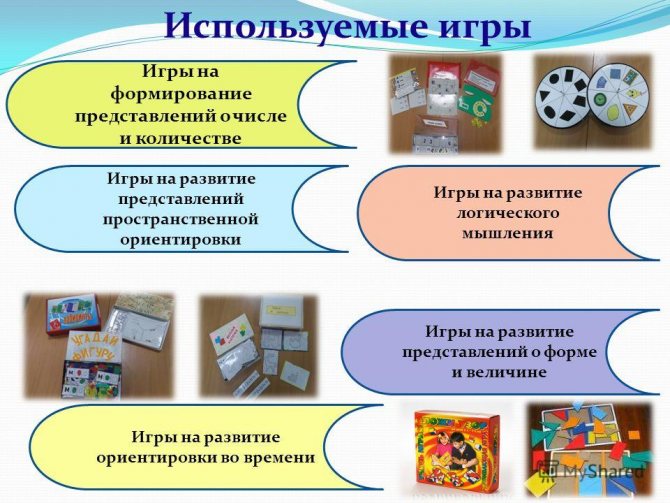
Games used in mathematics classes
- Introductory part. Logical warm-up. Includes the simplest tasks for children, which should “warm up” the child’s mind, interest him and prepare him for the lesson.
- The main part of the lesson, during which new material is studied to form mathematical concepts, or reinforcement of what has already been learned. Exercises can be selected using special methodological literature (a good example is the book compiled by E.I. Shcherbakova “Theory and Methods of Mathematical Development for Preschool Children”).
- 3Finger gymnastics. Redirects the child's attention and serves as a warning against fatigue. For the same purposes, you can use physical exercise (if the lesson was associated primarily with intellectual activity), articulatory gymnastics or eye exercises (if the child had an active lesson using outdoor games).
- Repetition of covered material.
- Drawing, lacing, or games aimed at developing fine motor skills.
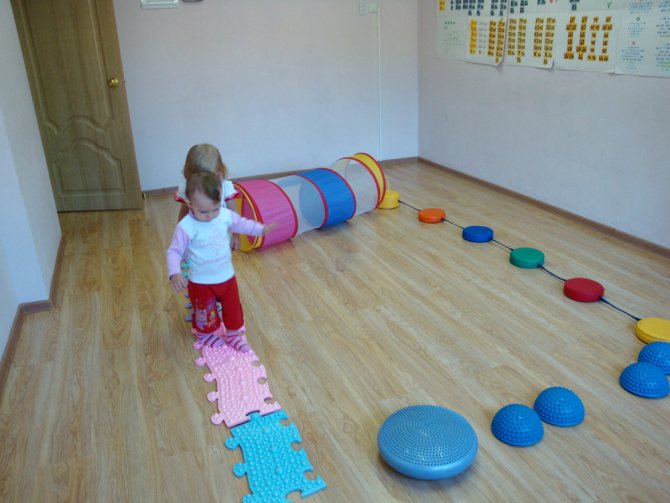
Developed mathematical skills in preschool children will allow him not only to successfully start school, but also to develop such qualities as perseverance, attention, and determination.
leave a comment
Mathematical development of preschoolers. article on mathematics on the topic
Mathematical development of preschool children.
The role of mathematics in modern science is constantly increasing. Today, an indisputable fact is that mathematics is needed for the intellectual development of an individual.
Preschool education is the first and most important link in the general education system. In preschool age, the foundation of ideas and concepts is laid, which ensures the successful mental development of the child. Both parents and teachers know that mathematics is a powerful factor in the intellectual development of a child, the formation of his cognitive and creative abilities. It is also known that the success of teaching mathematics in primary school depends on the effectiveness of a child’s mathematical development in preschool age.
The basis for the interpretation of the concept of “mathematical development” of preschool children was also laid in the works of L.A. Wenger. and today it is the most common in the theory and practice of teaching mathematics to preschoolers. “The purpose of teaching in kindergarten classes is for the child to master a certain range of knowledge and skills specified by the program. The development of mental abilities is achieved indirectly: in the process of acquiring knowledge. This is precisely the meaning of the widespread concept of “developmental education”. The developmental effect of training depends on what knowledge is imparted to children and what teaching methods are used.”
From the research of E.I. Shcherbakova, the mathematical development of preschool children should be understood as shifts and changes in the cognitive activity of the individual that occur as a result of the formation of elementary mathematical concepts and related logical operations. In other words, the mathematical development of preschool children is qualitative changes in the forms of their cognitive activity that occur as a result of children’s mastery of elementary mathematical concepts and related logical operations.
Among the tasks for the formation of elementary mathematical knowledge and the subsequent mathematical development of children, the main ones should be highlighted, namely:
-acquisition of knowledge about set, number, size, shape, space and time as the foundations of mathematical development;
-formation of a broad initial orientation in quantitative, spatial and temporal relations of the surrounding reality;
- formation of skills and abilities in counting, calculations, measurement, modeling, general educational skills;
-mastery of mathematical terminology;
-development of cognitive interests and abilities, logical thinking, general intellectual development of the child.
These problems are most often solved by the teacher simultaneously in each mathematics lesson, as well as in the process of organizing various types of independent children's activities.
In mathematics classes in kindergarten, the simplest types of practical and mental activity of children are formed. By types of activities - in this case, methods of examination, counting, measurement - are understood objective sequential actions that a child must perform to acquire knowledge: element-by-element comparison of two sets, imposing measures, etc. By mastering these actions, the child learns the purpose and methods of activity, as well as rules ensuring the formation of knowledge.
The central task of children's mathematical development in kindergarten is learning to count. The main methods for this are overlaying and applying, mastery of which anticipates learning to count with the help of numeral words.
At the same time, preschoolers are taught to compare objects by size (size) and designate the comparison results with appropriate words-concepts (“more - less”, “narrow - wide”, etc.), build rows of objects according to their size in increasing or decreasing order (large, small , even smaller, the smallest). However, in order for a child to master these concepts, it is necessary to form concrete ideas in him, to teach him to compare objects with each other, first directly - by superimposing, and then indirectly - by means of measurement.
Based on practical actions, children form such mental operations as analysis, synthesis, comparison, and generalization. In assessing the results of his work, the teacher should focus primarily on these indicators, on how children can compare, analyze, generalize, and draw conclusions. The level of children's mastery of mental operations depends on the use of special methodological techniques that allow children to practice comparison and generalization. Thus, children learn to compare sets by quantity, while carrying out structural and quantitative analysis of the set. Comparing objects by shape, children identify the size of individual elements, comparing them with each other.
A child’s mathematical development is not limited to teaching how to count, measure, and solve arithmetic problems. It also implies the development of the ability to see, discover properties, relationships, dependencies in the surrounding world, and be able to convey them with the help of signs and symbols.
The formation of initial mathematical concepts and actions goes through the same stages as any mental action. At the first stage, the child carries out counting operations only with the support of external objects. At the second stage, mathematical operations are carried out in terms of loud speech. This stage is divided into two stages. On the first, the child cannot complete the “2 + 2” task, but can easily complete “add 2 apples to 2 apples.” Thus, at the first stage, reliance on the visual image of the situation is a necessary condition for performing a mathematical operation. The second stage is defined as the stage of abstract speech, when the child performs actions based only on the naming of numerals. At the third stage, mathematical actions are carried out in terms of internal speech (P. Ya. Galperin, L. S. Georgiev).
In the implementation of cognitive activity (and mathematical activity is a specific cognitive activity), the leading role belongs to speech. When performing a practical action, the child must be able to verbalize this action. The ability to describe one’s action develops the ability to reason and justify a particular decision. In mathematics, when describing the properties of objects and their relationships, precise words are required - terms. The phrases used in mathematics classes are distinguished by a strictly specified order of word combinations. To successfully master counting operations, it is first necessary to master a certain linguistic level. In order to perceive definitions, a child must master the necessary vocabulary, understand their meaning, and accurately determine the nature of the logical-grammatical connections between words and sentences. The formation of the lexical and grammatical structure of speech is extremely important when solving arithmetic problems. Analyzing the text of the problem, the child must establish dependencies between the task data and highlight their logical connections.
Thus, a necessary condition for successful mastery of mathematics is the formation of many mental functions and processes. And, undoubtedly, one of the most important prerequisites for mastering counting operations is speech.
In the process of activating speech activity in FEMP classes, the following tasks are solved: 1. Formation of solid knowledge in all sections of elementary mathematics (quantity and counting, shape and size, orientation in space and on a plane, orientation in time) in accordance with the program. 2. Enrichment and activation of children’s vocabulary, using a variety of speech material and folklore in their work. To form a vocabulary, it is advisable to use visual and verbal material: funny poems about numbers; fairy tales, stories in which numbers are present; puzzles; puzzles; counters; sayings; teasing, etc. All this enriches vocabulary (including mathematics), trains attention and memory, lays the foundations for creativity, and develops explanatory and demonstrative speech. Folklore helps to create an emotional mood and activate the child’s mental activity. 3. Learning to use mathematical terms in your speech in accordance with the program material: - names of geometric shapes (circle, square, triangle, rectangle, quadrangle, polygon, oval, rhombus); — elements of shapes (corner, side, vertex); — computational actions (add, subtract, get, equal, quantity, figure, number, etc.); - comparative actions (more, less, longer, shorter, higher - lower, narrower - wider, thicker - thinner, etc.); - spatial relationships (top - bottom, in front - behind, left - right, nearby - far, etc.); 4. Activation of children's mental activity. 5. Development of attention, memory, imagination, thinking.
Work on activating speech activity in classes on the formation of elementary mathematical concepts is carried out in stages.
I. It begins with survey actions: feeling the number made of plastic, plywood, sandpaper and other materials. In the process of this type of activity, children learn to talk about their feelings and guesses, they develop motor and visual memory, thinking, attention, and speech.
II. Outlining numbers, shading, coloring. Children learn to coordinate the actions of both hands, develop an eye, precision of movements, neatness; in the course of completing the task, children’s knowledge of color, the location of numbers on a sheet, the ability to navigate on a plane, etc. is refined.
III. Composing a number from “Numbers” cubes and composing it from parts (the “Numbers” constructor) are aimed at developing analytical and synthetic activity, attention, memory, development of motor skills, and the ability to navigate in space.
IV. To develop imagination, the task “What does a number look like?” is carried out. Children learn to compare objects, identify signs of similarity and difference; in the process of carrying out this task, children develop creativity, imagination and speech.
V. Drawing numbers with a wet finger on the board, in the sand. In this task, the image of a number is consolidated, not only visually, but also motorically, children learn to correlate the verbal designation of a number with its graphic image.
VI. Reading poems about numbers, fairy tales that mention numbers, tongue twisters, etc. This helps children see the need to know numbers and their use in artistic creativity.
VII. Creating a collage of mathematical content from children's drawings, based on which children come up with fairy tales and stories. In the process of this type of work, children’s coherent speech develops, their vocabulary is enriched and activated, the ability to speak in front of listeners is formed, and the expressiveness of speech develops.
VIII. Coming up with first-person stories about numbers, for example: “I am one. I have a sharp nose. I’m very curious, I stick it everywhere, that’s why it became so long for me. Don’t come near me, otherwise I’ll inject you.” Such stories are written down in the “Baby Book”, which every child in the group has. The sequence of work on getting to know geometric shapes is built on the same principle.
When working to enhance the speech activity of children in FEMP classes, it is advisable to use Dienesh blocks, Cuisenaire sticks, didactic aids by M. Montessori, J. Piaget, M. Fiedler, etc. In the process of working with aids, children learn to verbalize their actions using mathematical terms, compare objects by color, size, quantity, shape. By creating images of birds and animals (“Tangram”), children remember songs, poems, stories, and come up with riddles.
As a rule, educational tasks in the classroom are solved in combination with educational ones. Thus, the teacher teaches children to be organized, independent, listen carefully, and do work efficiently and on time. This disciplines children and helps them develop focus, organization, and responsibility. Thus, teaching children mathematics from an early age ensures their comprehensive development.


